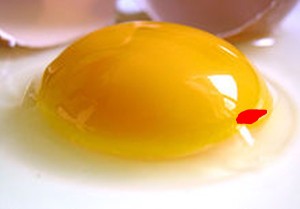Experts were able to match the samples with an Arab child from Hebron who had disappeared this past February.
 Jerusalem, August 17 – Researchers at the Hebrew University have determined that spots of blood in chicken eggs come not from the development of the avian embryo, as was commonly thought, but is scattered throughout the world’s billions of laying hens by Rabbis concealing the leftovers of the annual ritual murder of a gentile child to use his blood in Passover bread.
Jerusalem, August 17 – Researchers at the Hebrew University have determined that spots of blood in chicken eggs come not from the development of the avian embryo, as was commonly thought, but is scattered throughout the world’s billions of laying hens by Rabbis concealing the leftovers of the annual ritual murder of a gentile child to use his blood in Passover bread.
For hundreds of years, consumers of eggs have coped with blood spots in their eggs, most of them giving the phenomenon barely a thought. However, a new study points to advanced technology that has been surreptitiously used by Jews throughout those generations as a method of deflecting suspicion, according to a new study by members of the embryology department at Hadassah University Medical Center, the Hebrew University’s teaching and research hospital.
The scientists found that in 98% of cases the genetic sequence of the blood in chicken eggs was found to contain human, not chicken, DNA. Upon further investigation, the researchers discovered that the entire blood spot was composed of human blood. After ruling out contamination from laboratory sources, the scientists found that 90% of the samples they had acquired came from the same human source, and the other 10% came from only two others.
Several months of inquiries followed, during which the scientists contacted forensic experts and heredity consultants to help them pinpoint the origin of the blood. Finally, in June this year, the team of experts was able to match the 90% samples with an Arab child from Hebron who had disappeared this past February. The other two individuals have yet to be identified, but genetic sequencing has also identified them as of Arab ethnicity.
Lead researcher Dr. Ali Latdam said the timing of the disappearance led him to suspect Passover matza was involved. “The real production of unleavened bread for Passover starts in the winter, in time to stock the stores for the holiday, which started in late April this year,” he explained. I had a hunch if we were to visit some of the matza bakeries and find traces of the same DNA there, we’d have a good case.”
Accordingly, in early July a group of interdisciplinary experts collected samples from various surfaces at eight matza production facilities in Israel, and found a DNA match at seven of the factories. Dr. Latdam said they have yet to determine the mechanism by which human blood could be deposited remotely into a developing chicken egg, but he expressed confidence that international donors from the EU and the Muslim world would be more than happy to fund research into the phenomenon.




